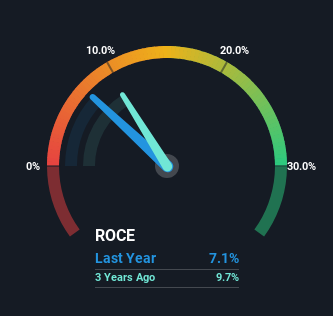- China
- /
- Auto Components
- /
- SHSE:603197
Returns On Capital Signal Tricky Times Ahead For Shanghai Baolong Automotive (SHSE:603197)
Finding a business that has the potential to grow substantially is not easy, but it is possible if we look at a few key financial metrics. In a perfect world, we'd like to see a company investing more capital into its business and ideally the returns earned from that capital are also increasing. Basically this means that a company has profitable initiatives that it can continue to reinvest in, which is a trait of a compounding machine. Although, when we looked at Shanghai Baolong Automotive (SHSE:603197), it didn't seem to tick all of these boxes.
Understanding Return On Capital Employed (ROCE)
If you haven't worked with ROCE before, it measures the 'return' (pre-tax profit) a company generates from capital employed in its business. Analysts use this formula to calculate it for Shanghai Baolong Automotive:
Return on Capital Employed = Earnings Before Interest and Tax (EBIT) ÷ (Total Assets - Current Liabilities)
0.071 = CN¥398m ÷ (CN¥9.6b - CN¥4.1b) (Based on the trailing twelve months to September 2024).
Thus, Shanghai Baolong Automotive has an ROCE of 7.1%. On its own that's a low return on capital but it's in line with the industry's average returns of 6.9%.
See our latest analysis for Shanghai Baolong Automotive

In the above chart we have measured Shanghai Baolong Automotive's prior ROCE against its prior performance, but the future is arguably more important. If you're interested, you can view the analysts predictions in our free analyst report for Shanghai Baolong Automotive .
What Does the ROCE Trend For Shanghai Baolong Automotive Tell Us?
On the surface, the trend of ROCE at Shanghai Baolong Automotive doesn't inspire confidence. Over the last five years, returns on capital have decreased to 7.1% from 9.8% five years ago. However, given capital employed and revenue have both increased it appears that the business is currently pursuing growth, at the consequence of short term returns. If these investments prove successful, this can bode very well for long term stock performance.
On a separate but related note, it's important to know that Shanghai Baolong Automotive has a current liabilities to total assets ratio of 42%, which we'd consider pretty high. This can bring about some risks because the company is basically operating with a rather large reliance on its suppliers or other sorts of short-term creditors. Ideally we'd like to see this reduce as that would mean fewer obligations bearing risks.
What We Can Learn From Shanghai Baolong Automotive's ROCE
In summary, despite lower returns in the short term, we're encouraged to see that Shanghai Baolong Automotive is reinvesting for growth and has higher sales as a result. And the stock has followed suit returning a meaningful 58% to shareholders over the last five years. So while investors seem to be recognizing these promising trends, we would look further into this stock to make sure the other metrics justify the positive view.
Since virtually every company faces some risks, it's worth knowing what they are, and we've spotted 4 warning signs for Shanghai Baolong Automotive (of which 1 shouldn't be ignored!) that you should know about.
For those who like to invest in solid companies, check out this free list of companies with solid balance sheets and high returns on equity.
New: Manage All Your Stock Portfolios in One Place
We've created the ultimate portfolio companion for stock investors, and it's free.
• Connect an unlimited number of Portfolios and see your total in one currency
• Be alerted to new Warning Signs or Risks via email or mobile
• Track the Fair Value of your stocks
Have feedback on this article? Concerned about the content? Get in touch with us directly. Alternatively, email editorial-team (at) simplywallst.com.
This article by Simply Wall St is general in nature. We provide commentary based on historical data and analyst forecasts only using an unbiased methodology and our articles are not intended to be financial advice. It does not constitute a recommendation to buy or sell any stock, and does not take account of your objectives, or your financial situation. We aim to bring you long-term focused analysis driven by fundamental data. Note that our analysis may not factor in the latest price-sensitive company announcements or qualitative material. Simply Wall St has no position in any stocks mentioned.
About SHSE:603197
Shanghai Baolong Automotive
Manufactures and sells automotive parts and components.
Reasonable growth potential with slight risk.
Similar Companies
Market Insights
Community Narratives




